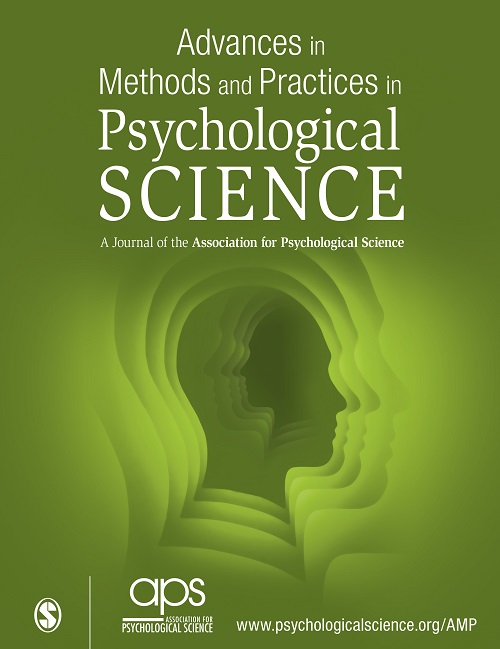Why Bayesian “Evidence for H1” in One Condition and Bayesian “Evidence for H0” in Another Condition Does Not Mean Good-Enough Bayesian Evidence for a Difference Between the Conditions
IF 13.4
1区 心理学
Q1 PSYCHOLOGY
Advances in Methods and Practices in Psychological Science
Pub Date : 2020-07-07
DOI:10.1177/2515245920913019
引用次数: 6
Abstract
Psychologists are often interested in whether an independent variable has a different effect in condition A than in condition B. To test such a question, one needs to directly compare the effect of that variable in the two conditions (i.e., test the interaction). Yet many researchers tend to stop when they find a significant test in one condition and a nonsignificant test in the other condition, deeming this as sufficient evidence for a difference between the two conditions. In this Tutorial, we aim to raise awareness of this inferential mistake when Bayes factors are used with conventional cutoffs to draw conclusions. For instance, some researchers might falsely conclude that there must be good-enough evidence for the interaction if they find good-enough Bayesian evidence for the alternative hypothesis, H1, in condition A and good-enough Bayesian evidence for the null hypothesis, H0, in condition B. The case study we introduce highlights that ignoring the test of the interaction can lead to unjustified conclusions and demonstrates that the principle that any assertion about the existence of an interaction necessitates the direct comparison of the conditions is as true for Bayesian as it is for frequentist statistics. We provide an R script of the analyses of the case study and a Shiny app that can be used with a 2 × 2 design to develop intuitions on this issue, and we introduce a rule of thumb with which one can estimate the sample size one might need to have a well-powered design.为什么一种情况下的贝叶斯“H1证据”和另一种情况下的贝叶斯“H0证据”并不意味着两种情况之间的差异有足够好的贝叶斯证据
心理学家经常感兴趣的是,一个自变量在条件a下的效果是否与在条件B下不同。要测试这样的问题,需要直接比较该变量在两种条件下的效果(即测试交互作用)。然而,当许多研究人员发现一种情况下有显著的测试,而另一种情况中有不显著的测试时,他们往往会停下来,认为这是两种情况之间差异的充分证据。在本教程中,我们旨在提高人们对这种推理错误的认识,当贝叶斯因子与传统的截断值一起使用来得出结论时。例如,一些研究人员可能会错误地得出结论,如果他们在条件A中为替代假设H1找到了足够好的贝叶斯证据,而在条件B中为零假设H0找到了足够的贝叶斯证据。我们介绍的案例研究强调,忽略交互作用的测试可能会导致不合理的结论,并证明任何关于交互作用存在的断言都需要直接比较条件的原则,对贝叶斯和频率统计来说都是正确的。我们提供了一个案例研究分析的R脚本和一个Shiny应用程序,该应用程序可以与2×2的设计一起使用,以发展对这个问题的直觉,我们还介绍了一个经验法则,用它可以估计一个强大的设计可能需要的样本量。
本文章由计算机程序翻译,如有差异,请以英文原文为准。
求助全文
约1分钟内获得全文
求助全文
来源期刊
CiteScore
21.20
自引率
0.70%
发文量
16
期刊介绍:
In 2021, Advances in Methods and Practices in Psychological Science will undergo a transition to become an open access journal. This journal focuses on publishing innovative developments in research methods, practices, and conduct within the field of psychological science. It embraces a wide range of areas and topics and encourages the integration of methodological and analytical questions.
The aim of AMPPS is to bring the latest methodological advances to researchers from various disciplines, even those who are not methodological experts. Therefore, the journal seeks submissions that are accessible to readers with different research interests and that represent the diverse research trends within the field of psychological science.
The types of content that AMPPS welcomes include articles that communicate advancements in methods, practices, and metascience, as well as empirical scientific best practices. Additionally, tutorials, commentaries, and simulation studies on new techniques and research tools are encouraged. The journal also aims to publish papers that bring advances from specialized subfields to a broader audience. Lastly, AMPPS accepts Registered Replication Reports, which focus on replicating important findings from previously published studies.
Overall, the transition of Advances in Methods and Practices in Psychological Science to an open access journal aims to increase accessibility and promote the dissemination of new developments in research methods and practices within the field of psychological science.

 求助内容:
求助内容: 应助结果提醒方式:
应助结果提醒方式:


